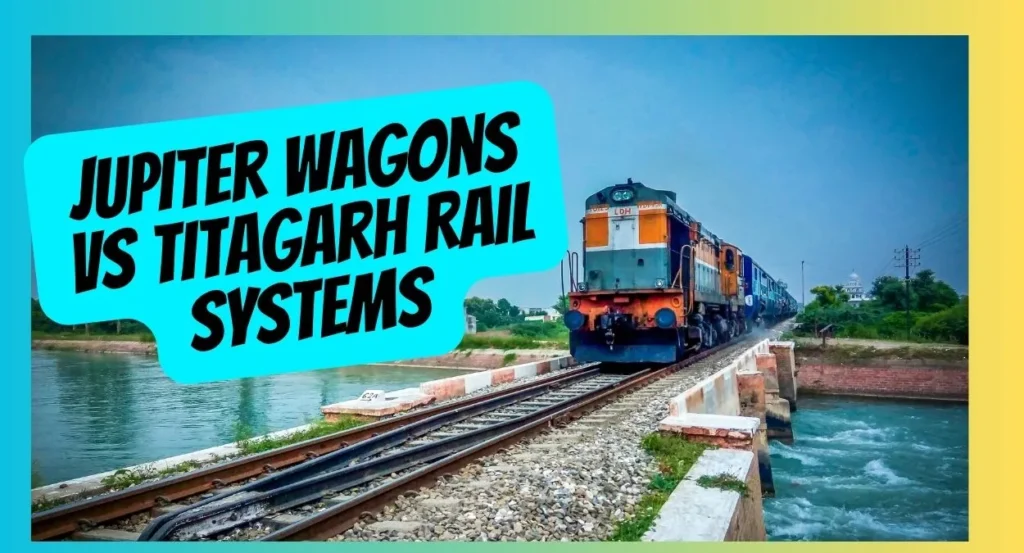India’s rapid infrastructure growth, particularly in railways and logistics, has created an immense opportunity for companies catering to the sector. Among the prominent players in this domain, Jupiter Wagons Limited (JWL) and Titagarh Rail Systems Limited (TRSL) stand out as strong contenders. Both companies are executing ambitious expansion plans and riding the railways and mobility revolution in India.
This article presents a comparative analysis of these two companies based on their FY25 earnings calls, strategic initiatives, and financial performance. It aims to determine which among them presents a better investment case for long-term investors.

Business Overview and Segment Strengths
Jupiter Wagons (JWL) has diversified its operations beyond freight wagons to include electric commercial vehicles (eLCVs), battery systems, brake systems, and a major foray into rail wheel manufacturing. Their transformation into a full-spectrum mobility solutions provider is noteworthy.
Titagarh Rail Systems (TRSL), on the other hand, has evolved into a comprehensive rail infrastructure player, with strong operations in freight wagons, passenger metro coaches (including Vande Bharat and international projects), propulsion systems, and shipbuilding. They’re also entering the safety and signaling systems domain.
Comparison:
- JWL: Broader diversification including electric vehicles and energy storage systems.
- TRSL: Deeper integration and leadership in passenger rail and defense-related shipbuilding.
Edge: Titagarh in terms of product depth and proven execution in multiple complex verticals.
Capacity Expansion and Future Growth
Jupiter Wagons:
- Building a ₹3,500 crore facility in Odisha for manufacturing rail wheels and axles.
- Target: 100,000 forged wheel sets annually.
- Expected full commissioning by early FY28.
- EV plant at Pithampur operational; targets 100 eLCVs/month shortly.
Titagarh Rail:
- Joint venture with Ramakrishna Forgings for 220,000 wheelsets annually (starting mid-2026).
- Ramp-up in coach manufacturing for Metro & Vande Bharat.
- Propulsion and safety systems gaining traction.
- Shipbuilding division being revamped for naval/defense supply.
Comparison:
- Both are aggressively investing, but TRSL’s JV model de-risks capital expenditure while leveraging technical partnerships.
- JWL’s ownership structure gives higher returns if successful, but carries more project execution risk.
Edge: Titagarh for lower-risk execution; Jupiter for potentially higher upside (with more equity skin in the game).
Strategic Partnerships and Technological Edge
- Jupiter: Strong domestic supply chain; JV with DAKO (brake systems); Tatravagonka (Europe) acts as strategic and technical collaborator.
- Titagarh: Deep partnerships with CRRC (Bangalore Metro), MERMEC (signaling systems), and strong ties with Indian Railways. JV with RKFL for wheels gives scale and capital efficiency.
Edge: Titagarh, due to broader and more diversified global collaborations.
Risk Factors
Jupiter Wagons:
- Heavy CAPEX of ₹3,500 crore funded with 65% debt.
- Short-term execution bottlenecks due to labor and wheelset shortages.
- New businesses (eLCVs, batteries) yet to scale commercially.
Titagarh Rail:
- Dependent on timely approval of new metro tenders.
- Potential geopolitical risks via partnerships (e.g., CRRC-China).
- Titagarh Firema (Italy) has seen some audit concerns but impact limited to book value.
Edge: Titagarh, for lower financial gearing and smoother project timelines.
Market Position and Outlook
Jupiter Wagons:
- Dominant in private freight wagons.
- Well positioned for India’s Make-in-India rail infra vision.
- Targeting ₹10,000 crore revenue by FY28.
Titagarh Rail:
- Largest producer of wagons in FY25 (9,431 units).
- Ambitious ramp-up across passenger and defense.
- Capacity to produce 12,000 wagons + 50 metro/Vande Bharat cars per month by FY27.
Edge: Titagarh, based on operational scale and diversification.
Corporate Governance & Transparency
Jupiter Wagons (JWL):
- Management is actively involved in investor interactions.
- Promoter group includes European partner Tatravagonka, which holds ~19%, though they are not on the board yet (planned soon).
- Some concerns emerged due to labor unrest in a plant and delays in EV rollout.
Titagarh Rail Systems (TRSL):
- Well-structured Board with experienced leadership.
- Disclosures around joint ventures, segment-wise financials, and order book breakdowns are detailed and investor-friendly.
- Conservative approach to announcing partnerships; emphasizes finalized ventures only.
Edge: Titagarh, due to higher transparency, global management practices, and robust investor communication.
Export Potential & Global Presence
Jupiter Wagons:
- Currently focused more on the Indian market.
- Future export opportunities planned via Odisha wheel plant through the Tatravagonka partnership.
- Limited export activity as of FY25.
Titagarh Rail:
- Exports include metro coaches, shipbuilding (including defense vessels), and joint projects in Europe through Titagarh Firema.
- Already supplied oceanographic vessels to Guyana and collaborated with GRSE and Indian Navy.
- High strategic leverage through international alliances (CRRC, Firema, MERMEC).
Edge: Titagarh, with an established international footprint and more credible execution history in exports.
Innovation & R&D Capability
Jupiter Wagons:
- Significant investments in electric vehicle design and battery systems.
- Manufacturing eLCVs and advanced battery packs (for forklifts, Vande Bharat trains, etc.).
- Odisha project includes first-of-its-kind private wheel/axle facility in India.
Titagarh Rail:
- In-house propulsion technology for EMU/MEMU approved and expected to scale up in FY26–27.
- Participating in safety and signaling system tenders with global technology partners.
- Expanding foundry and backward integration for cost and quality control.
Edge: Tie, as both are innovation-driven — Jupiter with green mobility and energy storage; Titagarh with rail tech and propulsion systems.
Conclusion: Which Is the Better Long-Term Bet?
Both Jupiter Wagons and Titagarh Rail offer compelling long-term growth narratives rooted in India’s infrastructure expansion. However, the better long-term investment comes down to risk-adjusted execution, diversification, and capital efficiency.
Winner: Titagarh Rail Systems Limited
Why?
- Proven multi-vertical execution.
- Strongest wagon production and foundry capacities.
- Robust JV-led CAPEX strategy (less financial risk).
- Passenger rail and propulsion systems offer long-term growth visibility.
- Scaling up shipbuilding and signaling opens new verticals.
Jupiter Wagons remains a solid contender, especially if its EV and wheel plant strategies deliver as expected. However, its higher debt exposure and early-stage businesses require more monitoring and carry higher execution risk.
